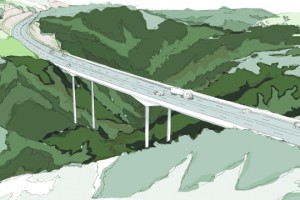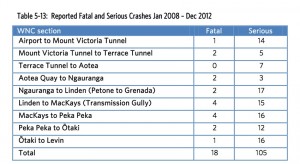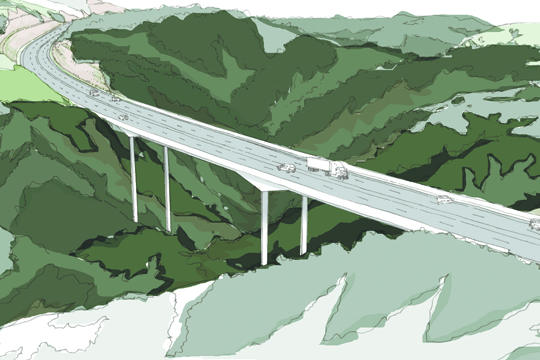
John Key announced last week that the Government would be signing the contract and starting construction on Transmission Gully before the next election. Talkback hosts and people who listen to them reacted with jubilation. Finally! A four lane expressway from the airport to Levin.
Although this project has been talked about for a long time, that doesn’t make it the best use of a huge amount of public money in the 21st century. Traffic volumes have been falling along the route for the past few years, as vehicle trips per capita have been declining across New Zealand and other comparable countries.
This is entirely unsurprising. I co-authored a report for the NZTA in 2008 called Managing Transport Challenges as Oil Prices Rise. We predicted (correctly) that high oil prices would reduce people’s ability to travel by car and reduce the amount of disposable income they had to spend in the local economy.
As oil prices bit into purchasing power, the economy slowed (globally and locally). Immediately after the GFC, oil prices collapsed – but not for long. Petrol has been back at record prices in New Zealand, and that’s with our dollar relatively high.
So, commuting long distance and moving goods by road isn’t as popular as it once was. People are reducing trips, car-pooling, looking to live closer to work or work closer to home, and looking for energy-efficient alternatives like rail. Fuel-efficient vehicles haven’t magically materialised and replaced the entire fleet, because most people can’t afford to rush out and buy a new car.
Oil prices aren’t the only factor. An ageing population, changing consumer preferences, the need to respond to climate change, and the high costs of car-dependence are all reasons to think building new roads isn’t the best way to meet future travel needs.
I’ve heard the road north of Wellington is a mess, so it inevitably has to be replaced. I have driven it at various times of day and never encountered a problem, but as I avoid driving whenever possible, I’m not a regular user of the route. The commuters and businesses who use it every day would probably have a few stories to tell. But building a new road isn’t a good way to deal with peak congestion. Queues are caused by a relatively small number of vehicles. You know how traffic is free-flowing during school holidays? A reduction of about 5-10% of cars can result in free flowing conditions. This is why it makes a lot more sense to provide incentives and alternatives to a small number of commuters to free up the roads for those who need to drive. It’s MASSIVELY cheaper and more effective than building a duplicate highway in challenging terrain.
If we spend billions making it cheaper and easier to drive, more people will drive. And then train services get cut because not enough people are using them, so even more people have to drive even if they’d rather not. Eventually all these cars and trucks have to get off the new highway and onto city streets. And BOOM! We’ve got the same massive traffic problems in Wellington that Auckland has been suffering from for decades. Ironically, in the name of reducing congestion, the Government is subsidising vehicles to travel long distance.
Because it’s been difficult to make the economics of the project stack up, the Government is selling earthquake fears as the imperative for the acceleration of the project.
But if we have billions to spend on making Wellington resilient to earthquakes, wouldn’t it be better spent on existing buildings and contingency planning for sea and air access? The road network is only as good as the weakest link, and motorways can’t move large volumes of people in a hurry, so it’s quite vulnerable to disruption to all the other roads. Not to mention TG crosses two fault lines and will have 29 bridges over extremely challenging terrain. Invincible? Yeah, just like the Titanic, I’m sure it will be a miraculous and infallible feat of human engineering.
More to the point, if we’re spending billions on reducing risks, how about the much more immediate, pressing and certain risk of sustained high oil prices to the country? Or of highly car-dependent transport system to health and safety of all New Zealanders?
Bizarrely, John Key said on the radio “155 people a year lose their lives on that stretch of road” (right after saying that the Greens were stupid…) In fact the total fatalities on the entire Wellington Northern Corridor route were 18 for the five year period from January 2008 – December 2012.

Which is not to say it’s okay that 18 people lost their lives on the road – but we can save more lives spending the same amount of money on a much larger number of transport improvements, including targeted improvements to this route. The very data cited in NZTA’s latest assessment of the Wellington RoNS to justify the safety benefits of Transmission Gully shows that the route has already shifted from medium risk to low risk over the last five years in terms of fatalities per kilometre travelled, while SH2 from Featherston to Upper Hutt is high risk.
The project is outdated and has a large opportunity cost. It’s money that won’t be available to spend on transport projects with greater benefits. Wellingtonians of a certain age seem to be completely convinced it will save the region, but all the evidence from around the world shows that urban highways aggravate traffic, result in people travelling longer distances and having to spend more money just to get around. That’s not good for the economy, and it will diminish Wellington’s natural character and advantages as a compact, public transport friendly region.
Of course, the worst part about the project is not that we’ll be spending $1 billion on a highway that will only be used by 0.2% of daily vehicle trips, which would be better spent on reliable trains, frequent buses, safe walking and cycling, and smart safety improvements to a lot more roads. It’s that we’ll be spending $3 billion it. For no additional benefit to anyone but the private overseas investors.






Doesn’t the table actually show fatal CRASHES not fatalities. More than one person might die in a fatal crash. I doubt that there have been 8 deaths per crash so John Key’s count is still bizarre but it is not necessarily only 18 people.
Fair point! I don’t know for sure if the numbers in the table are given in terms of people or crashes. Remember the table shows 5 years of crashes, not one year.
I do have data on road deaths for the entire region, which shows 10, 13 and 11 road fatalities the last three years (this includes pedestrians, cyclists, etc). Consistently lower total road deaths in Wellington than other regions including Gisborne/Hawkes Bay, Waikato, Canterbury, Manawatu/Whanganui.
People from the Hutt Valley and Western suburbs would find it very inconvenient having to go in to Wellington to catch a train North to Kapiti. It would add around 40 to 60 mins per journey meaning a return trip that coukd take around an hour with the new motorway will take around three times longer using the train.
That fails to make any valid point Gossy.
People from the Hutt Valley or Wairarapa are still going to either continue to go in to Wellington to connect with the new motorway – or continue to trek over the Haywards Hill to join up at the nightmare junctions.
Ms Genter’s assumption that people will stop using the train if roads are built – there’s something about the costs of public transport that is so off-putting. And the lack of feeder transport. And the awkwardness of cross-route travel, which make private transport so much more attractive. Make it easy. Not everyone can ride a bike or hike two k to the station in the rain to stand by the graffiti and long for a clean loo.
Perhaps those yelling, ‘Whoopee! At last!’ are those unfortunates living anywhere from Plimmerton north who have endless traffic crawling through their 50kpm residential areas every every day of the week and worse on ‘Let’s go to the beach!’ days when so many in the region swarm out to enjoy sandy beaches.
Should the day come when we leave behind the combustion engine and have something more environmentally friendly by far – we’ll still be pleased with decent roads for travel that don’t wreck the suburban dwellers’ comfort and peaceful enjoyment of their homes.
Further: there are plenty of older drivers who wander the national roads to visit far-flung friends and events. They don’t all give up and collapse in front of the telly.
And that would be the only reason that National is building it. More corporate welfare for their rich mates.
Of course there won’t be a 4 lane expressway from Wellington to the Airport, there will still be a gap between the Terrace Tunnel and the Basin reserve. From my experience this is the slowest, congested part as goes through city streets and lots of traffic lights. Once the Wellington RONS are finished will be huge pressure to build the original inner city bypass plan, which would be a trench along Arthur and/or Vivian St, which would cost easily cost half a billion dollars, and be hugely destructive and disruptive.
NZTA claim that haven’t investigated this when I OIAed them, but still will be inevitable. Northern corridor especially pointless without this link so none of it should proceed, because sorting this hugely unpopular.
Comments are closed.